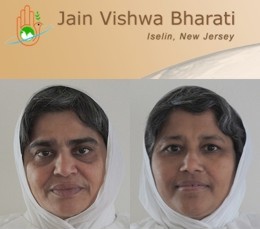
Paryushan and Samvatsari Evening Samayik, Pratikraman, and Pravachan were held at VFW Hall at South Plainfield, NJ, on all 8 days of Paryushan from Aug 22-29. Many people attended the sessions everyday. Samaniji 's pravachan emphasized on the importance of the different spiritual practices in our lives.
Day 1 Power of Samayik
Samaniji explained the benefits of Samayik. Samayik is the time that you try to detach yourself from the outside world and focus on your spirituality or inner soul. Samayik is also the purification of soul from the bondings and is also a form of meditation. Samayik is usually practiced for 48 minutes a day. Samaniji also said if you practice 5 minutes of meditation everyday, it’ll help you to get closer to your inner self.
Day 2 Power of Logassa
Samaniji explained the power of Logassa. The reasons behind the logassa is a tribute to all 24 tirthankars. Not only it is a tribute, some of the verses in this mantras has power such as “Arogga Bohi Lahbham” is a pain reliever mantra, “Sagar-vara-gambhira” is positive attitude mantra, “Aa-ichchesu Ahiyam paya sayara” stimulates the power of intuition, and “Chandesu Nimmala-Yara" promotes peace of mind.
All of these mantras have immense power when one does it the correct way. Samaniji also explained if one can do 36 Logassa a day for a month, it’s equal to 15 upvas.
Day 3 Power of Swadhyay
Samaniji explained the purpose of swadhyay which is the reading or listening of spiritual books or discourses. Topics of swadhyay focus on the bigger questions such as: “Who am I?”, “Where am I?”, and of course focus on the soul. The information on most of the Jain books are same whether one is Shwetambar, Digambar, etc. but the way of relaying the information are different among the groups.
Day 4 Power of Pratikraman
Purpose of Pratikraman is to look into your past actions and repent for these actions and purify the soul at the same time, Samaniji explained. There are 2 types of Pratikraman, one is a ritual pratikraman which is a shorter version and shorter timing than the other kind, which is the spiritual pratikraman. Spiritual pratikraman focuses on the control of anger, desires, and ego. It also can lead us to the final destination moksha if practiced wholeheartedly and with awareness. Also by doing the pratikraman, one doesn’t have enemies from the smallest beings to humans.
Day 5 Power of Mantra
Mantras are the essence of ultimate knowledge especially Navkar Mantra, which is the essence of the knowledge of 14 Purvas. The purpose of this mantra is the release of the desires and ego and it also provides the cure for one’s ailments. Samaniji provided the framework of how the mantra works - based on which part of your body and what color to focus on while chanting, and its purpose: Namo Arihantanam (Gyan Kendra): crown of head, white, knowledge Namo Siddhanam (Darshan Kendra): third eye (middle of the forehead between 2 eyes), red/orange, concentration Namo Aayariaanam (Vishu Kendra): throat, yellow, purity Namo Uvajhayaanam (Anand Kendra): heart/chest, green, enjoyment or bliss Namo Loe Savvasahoonam (Shakti Kendra): naval, blue, strength
Day 6 Power of Kayotsarg
Kayotsarg is the detachment of your body from the soul. Meditation and mantra can help you gain better perspective and eventually lead you to bliss and detachment from pain, desire, and ego. It also can relieve your ailments such as backache, sleeping issues, and stress. Any mantra can help you to focus on how to detach from the worldly desires, relationship, and material and focus on the soul only. One should learn how to perform their daily duties with no expectations.
Day 7 Power of Pratyakhyan (Vows)
Samaniji explained the purpose of pratyakhyan or vows, limiting yourselves to what you can do in a day such as not eating more than 15 items a day, buying certain number of clothes a year, upvas etc. There are 2 kinds of pratyakhyan: material vows and spiritual vows. Material vows focus on outer needs such as foods, clothes, shoes, etc. and spiritual vows focus on inner need such as anger, sadness, greed,etc. Material and spiritual vows work together and these vows help you to realize your inner soul.
Day 8 Power of Kshamapana and Samvatsari
Kshamapana and Samvatsari symbolize the cleansing of our inner beings from the enmities toward anyone such as family, friends, and others who we may have had contact with. It is another way of asking forgiveness to be freed from the karmas.
In addition to evening sessions, morning swadhyay sessions were held everyday at the JVBNA center. During these sessions, Samanijis discussed the meaning of Pratikraman, and touched upon 18 Bhavanas. All morning and evening sessions were very well received and well attended. | 
